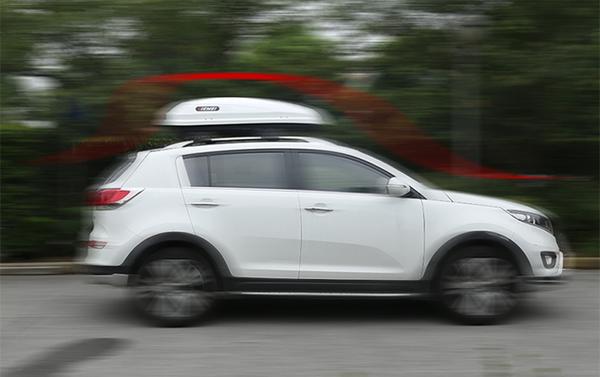April 12, 2021
HOW MUCH HAS THE FUEL CONSUMPTION OF THE ROOF LUGGAGE CHANGED?
One, for the roof box itself
1. The size of the roof luggage box The size of the roof luggage box on the market varies. Generally speaking, the larger the luggage box, the more fuel it consumes. Generally speaking, the size of the luggage box on the market is 350L, 400L, 480L. The difference between the sizes of 500L, 600L and 690L. Therefore, the fuel consumption has to be divided according to the size of the suitcase you choose. According to the data we measured, in the urban area with a full load of 500L luggage, the fuel consumption will basically be 1.3~1.8 points more. There is basically no resistance in the urban area.
2. The structure of the roof luggage box. Now some larger roof boxes will take air resistance into consideration in the design. Therefore, the design will be designed to be flatter according to aerodynamics, so that the wind resistance will be smaller and the airflow will be guided. Above the body. The smaller roof luggage box does not have enough space to flatten the design, reduce wind resistance, and direct the airflow above the luggage box. The design is higher, so the wind resistance will be slightly larger. There is basically no obvious difference in the urban area, but after the high-speed speed reaches 120, the wind resistance is more obvious.

Second, in terms of road conditions. Fuel consumption and resistance on high-speed road conditions will be more obvious than those in urban areas. Under normal circumstances, fuel consumption at high speeds will be much lower. However, if a full container of cargo is added to the roof box after being fully loaded, fuel consumption will not be as low as before. , May be similar to the city. At the same time, the speed is up at high speed, and the resistance will be more obvious than that. Therefore, this change is more obvious. On the contrary, if the speed cannot rise in the urban area, the resistance will not be much felt. The only possibility to feel the change is the fuel consumption. In the urban area, the fuel consumption is affected by the road conditions. Therefore, if you drive more in urban areas, there will be basically no obvious changes in fuel consumption and resistance.
1. The size of the roof luggage box The size of the roof luggage box on the market varies. Generally speaking, the larger the luggage box, the more fuel it consumes. Generally speaking, the size of the luggage box on the market is 350L, 400L, 480L. The difference between the sizes of 500L, 600L and 690L. Therefore, the fuel consumption has to be divided according to the size of the suitcase you choose. According to the data we measured, in the urban area with a full load of 500L luggage, the fuel consumption will basically be 1.3~1.8 points more. There is basically no resistance in the urban area.
2. The structure of the roof luggage box. Now some larger roof boxes will take air resistance into consideration in the design. Therefore, the design will be designed to be flatter according to aerodynamics, so that the wind resistance will be smaller and the airflow will be guided. Above the body. The smaller roof luggage box does not have enough space to flatten the design, reduce wind resistance, and direct the airflow above the luggage box. The design is higher, so the wind resistance will be slightly larger. There is basically no obvious difference in the urban area, but after the high-speed speed reaches 120, the wind resistance is more obvious.

Second, in terms of road conditions. Fuel consumption and resistance on high-speed road conditions will be more obvious than those in urban areas. Under normal circumstances, fuel consumption at high speeds will be much lower. However, if a full container of cargo is added to the roof box after being fully loaded, fuel consumption will not be as low as before. , May be similar to the city. At the same time, the speed is up at high speed, and the resistance will be more obvious than that. Therefore, this change is more obvious. On the contrary, if the speed cannot rise in the urban area, the resistance will not be much felt. The only possibility to feel the change is the fuel consumption. In the urban area, the fuel consumption is affected by the road conditions. Therefore, if you drive more in urban areas, there will be basically no obvious changes in fuel consumption and resistance.
